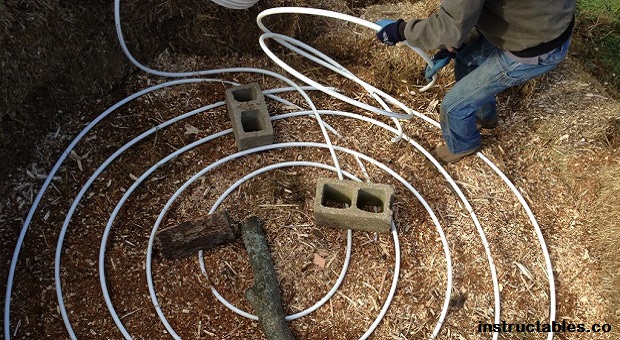I bet you never thought about using compost to generate heat, did you? Mulch and compost are basically biomass and as it decomposes naturally, biomass creates heat as a byproduct. Why wouldn’t you make use of this heat?
If you’re new on Survivopedia, we already published a few articles about the numerous benefits of compost and mulch for your household. We talk about what mulch and compost is, how can you DIY, what can you use it for, what are the best kinds of materials to use and so on. Just follow the links to get the general idea.
Long story short, let’s to put the compost to work for us again!
The Magic Behind the Process
The idea behind using compost or mulch for heating is to capture as much of the generated heat as possible and use it for various purposes around the house such as reducing your electricity bill, heating bill etc.
Since any pile of compost, if big enough and healthy enough, produces a reasonable amount of heat during the decomposition process, you can use the respective heat for warming water. When I say healthy, I mean that it has a good ratio (1:1) of nitrogen and carbon.
Of course, you’ll save money on your energy bill by doing this and you’ll also reduce the amount of garbage that you send to landfills (again, saving money in the process).
It’s a win-win situation, regardless how you look at it.
Biodegradation is the process that makes the magic things happen in your compost pile and that means that the trillions of microorganisms living in your compost or mulch must be “happy” if you want to obtain the best results.
For a high rate of biodegradation (as in successful composting) you must achieve an optimum level of aeration, balance (in terms of nutrients) and moisture in your compost mound.
All these elements, working in harmony with the fungi and bacteria that “feast” on the waste matter which is part of the compost, end up turning it into humus, water and carbon dioxide. Humus is basically the “end product” of composting and heat is the highly beneficial byproduct of the process of biodegradation, i.e. the conversion of organic matter after it has been eaten by microorganisms.
It sounds a bit complicated, but actually it’s very straightforward after you begin to grasp the concept.
Now, if you want to use the heat that results from composting, you must know that a faster compost rate results in more heat generated during the process.
If you want to achieve the best results, i.e. the most heat, you’ll have to use big piles. The heaps must be at least 3 cubic feet or more while the perfect compost mound measures 4-5 feet in all directions. Only mounds this size or larger are able to generate temperatures over 140 degrees Fahrenheit.
The most heat is generated in the center of the compost mound; that’s the “hot spot”. The hottest temperatures obtained in such piles can be as high as 160 degrees Fahrenheit in “hot” setups.
This is a respectable figure if you’re taking into account that the USDE (the Department of Energy) recommends 120 degrees Fahrenheit as the ideal temperature for heating the water in your household.
This article has been written by Chris Black for Survivopedia.











































































Great article and an excellent use of bio-mass that’s normally throw away. Nothing better than free and all you need is some elbow grease and common sense (now THAT’s a commodity).
Historically…people would dig out a cellar type space with an entrance/ exit ramp , small windows and a drainage system. The luckiest ones were able to do this using higher ground and had nearby water access and/or a good well.
The idea was to live above your underground”barn”. The hay nd grasseaters would be driven into their spaces or would just come automatically (goats, sheep, burros. Milk cow and chickens, horses,??) They’d be fed watered sheltered milked, etc.
The family above would reap the warmth and had only to climb down a ladder to care for and “harvest” food.
The people generally had managed to put in hay,food before and inbetween storms. Mucking out would be done but left in a corner until weather permitted it to be hauled out. During times of bad ice/snow storms everyone stayed safe and cosy.
Im sure youve gotten the idea. Just thought I’d mention. History can be grand!!! Besides the primatives weren’t stupid or we wouldn’t be here.
You’re quite right, Pam. The situation you describe is truly ideal. While some would claim the stench from below would be intolerable, that could be true had the use of lime and sawdust not been also used.
In a modern set-up, such as this, one could also include a grow room for vegetables and mushrooms. The possibilities are endless. All one has to do is give it some serious thought before putting mortar to brick.
And you’re also right about our ancestors – they weren’t stupid. The only thing they lacked was modern tools and equipment. Certainly not brains…
Good info. I will try burying 750 gal foodgrade water containerwith a pressure
feed and a return to house for hot water system. Need to sstudy compost materials other than leaves woodchips and manure.
Any vegetable matter will work. The fresher the better.
Try to stay away from meats or fish as they’re prone to unwanted bacteria and, of course, stench. Planting fish in the garden, however, is an old, Native American, trick. Herring was the fish of choice in New England as it was plentiful. Fish is safer here as you don’t normally handle it like you would compost. Just bury the fish, in rows, during their “run”, let it set for a few weeks and then till it well. You’ll have some awesome veggies at harvest.
If it rots – it heats. People tend to over-analyze these days. Keep it simple and you’ll do fine.